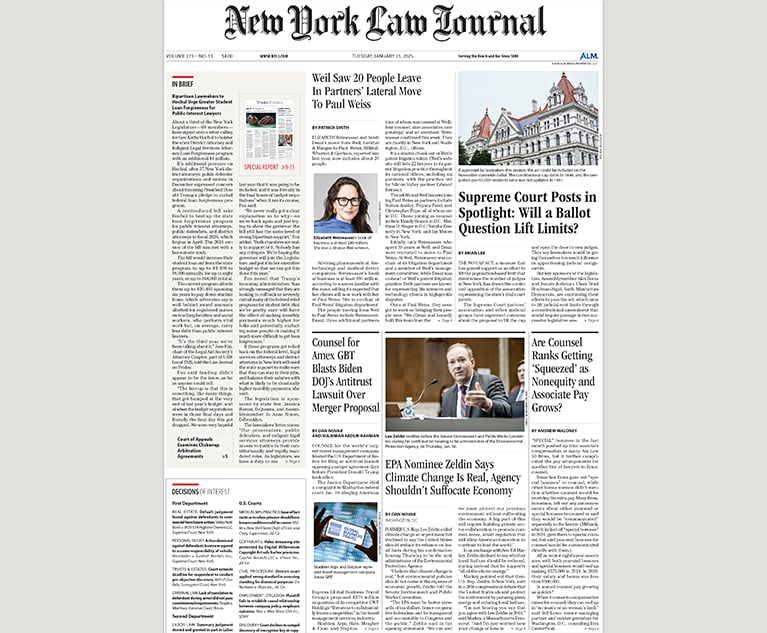New Practice Rules of the Appellate Division
Appellate Practice columnists Thomas R. Newman and Steven J. Ahmuty Jr. examine several major provisions of the new uniform rules, including electronic filing requirements, filing deadlines for appellate submissions, and motion practice.
November 06, 2018 at 02:45 PM
10 minute read
 Thomas R. Newman and Steven J. Ahmuty Jr.
Thomas R. Newman and Steven J. Ahmuty Jr.
On June 29, 2018 the Presiding Justices of the Appellate Division promulgated statewide Practice Rules of the Appellate Division (22 NYCRR Part 1250). These rules became effective on Sept. 17, 2018, and apply to (1) “all matters that are commenced in the Appellate Division, or in which a notice of appeal to the Appellate Division is filed, on or before the effective date,” and (2) all matters pending in the Appellate Division on the effective date, unless otherwise ordered by the court upon a showing that application of the new rules to a particular matter “would result in substantial prejudice to a party or would be manifestly unjust or impracticable under the circumstances.” See Joint Order of the Departments of the New York State Supreme Court, Appellate Division, dated June 29, 2018.
This month, we examine several major provisions of the new uniform rules, including electronic filing requirements, filing deadlines for appellate submissions, and motion practice. These rules have not achieved complete “uniformity,” however, since each Department has promulgated individual rules that supplement Part 1250. See 22 NYCRR Part 600 [First Department], Part 670 [Second Department], Part 850 [Third Department], and Part 1000 [Fourth Department]). Where a conflict exists between Part 1250 and the local rules, the latter control. See 22 NYCRR §§600.1[a], 670.1[a], 850.1[a], 1000.1[a].
Electronic Filing Requirements
Rule 1250.8 standardizes the form and content of briefs, including word limitations for computer-generated briefs (14,000 words for appellant's and respondent's briefs, and 7,000 words for reply and amicus curiae briefs). See id. at [f][2].
Under Rule 1250.9[a], [c] and [d], one digital copy of each party's brief, and one digital copy of the record on appeal or appendix, must be electronically filed in addition to an original and five copies in paper format. For e-filed cases, digital briefs are uploaded to the New York State Courts Electronic Filing system website (NYSCEF). In other cases, digital briefs are uploaded to the court's website. Pro se or unrepresented parties are exempt from this electronic filing requirement. See 22 NYCRR §1250.9[e].
The Electronic Filing Rules of the Appellate Division (22 NYCRR Part 1245) supplement and must be read in conjunction with the requirements of Rule 1250.9. For example, under Rule 1245.5[f], digital copies of briefs must comply with the formatting requirements in “Attachment A” thereto, which requires that e-filed documents must “(a) be identical in content to the hard copy; (b) comply with text searchable PDF archival format (PDF/A); (c) contain bookmarks linking the tables of contents of briefs and records to the corresponding page of the document; (d) be paginated to correspond to the hard copy; and (e) be scanned at a resolution sufficient to ensure legibility.”
Rule 1245.4[a][2] also exempts from the electronic filing requirements “attorneys who certify in good faith, on a form provided by the Appellate Division, that they lack either (i) the computer hardware and/or connection to the internet and/or scanner or other device by which documents may be converted to an electronic format; or (ii) the requisite knowledge in the operation of such computers and/or scanners necessary to participate, pursuant to CPLR 2111(b)(3)(A) or (B).”
The Second Department has promulgated “Technical Guidelines” that supplement Part 1245 and govern the format of briefs and motion papers. For example, in addition to the bookmarking requirement in “Attachment A,” “[a]ll electronically-filed briefs should contain bookmarks to the authorities cited in those briefs. Those bookmarks should take the reader to a copy of the cited authority, that is, the case, statute or rule, which will be part of the brief submitted.” Thus, cited authorities must be hyperlinked to a PDF of the cited authority, which must be attached to the digital copy of the brief. Similarly, “[a]ll electronically-filed motions and papers filed in opposition or relation to motions, should be filed in one PDF document, which shall contain bookmarks linking each separate document contained therein.”
Filing Deadlines for Appellate Submissions
Consistent with prior practice, in all civil matters the appellant's counsel must file in the court of original instance and serve on all parties, together with the notice of appeal and the order or judgment appealed from, an initial informational statement on a form approved by the Appellate Division. The clerk of the court from which the appeal is taken then transmits to the Appellate Division the informational statement and accompanying papers. See 22 NYCRR §1250.3[a].
There is an additional initial filing requirement in appeals designated for e-filing. In such cases the appellant's counsel must within 14 days of filing of the notice of appeal (1) register or confirm registration as an authorized e-filer with NYSCEF; and (2) enter in NYSCEF such information about the appeal and parties, and e-file such documents, as the Appellate Division requires. See 22 NYCRR §1245.3[a]. The Appellate Division then issues a case or docket number, notification of which must be served on all parties. See 22 NYCRR §1245.3[b].
Within 20 days of service of the notification of the Appellate Division case or docket number, the respondent must (1) register or confirm registration as an authorized e-filer with NYSCEF; and (2) enter in NYSCEF such contact information and additional information as the Appellate Division requires. See 22 NYCRR §1245.3[d]. Prior to the expiration of the respondent's 20-day grace period, filing and service of documents by, and service upon, parties who have not entered the requisite information must be in hard copy.
The Appellate Division may direct that any matter be “actively managed” and may establish a scheduling order specifying the time and manner of expedited briefing. See 22 NYCRR §1250.3[b]. Except where the Appellate Division has ordered that an appeal be perfected by a date certain, an appellant must file the record or appendix and opening brief within six months of the date of the notice of appeal (see 22 NYCRR §1250.9[a]), thereby standardizing this important deadline in the four Departments.
As noted, the new rules apply to notices of appeal filed “on or before” the effective date of Sept. 17, 2018, such that the six-month perfection deadline applies to notices of appeal filed on or after March 17, 2018. In such cases, counsel should expeditiously avail themselves of the following extension provisions.
Except where the Appellate Division has ordered that an appeal be perfected by a date certain, the parties may stipulate, or in the alternative an appellant may apply by letter on notice to all parties, to extend the time to perfect an appeal up to 60 days. See 22 NYCRR §1250.9[b]. The appellant may thereafter apply by letter, on notice to all parties, to extend the time to perfect by up to an additional 30 days. Id. Any further application for an extension of time to perfect the appeal must be made by motion. Id.
The respondent must file an answering brief within 30 days of the date of service of the appellant's submissions or, in the First Department (which has preserved its “term calendar”), in accordance with that court's published filing deadlines for each term. See 22 NYCRR §1250.9[c]. The appellant may file a reply brief within 10 days of the date of service of the respondent's submissions or, in the First Department, in accordance with that court's filing deadlines for each term. See 22 NYCRR §1250.9[d].
Except where the Appellate Division has ordered that answering or reply briefs be served and filed by a date certain, the parties may stipulate or a party may apply by letter on notice to all parties to extend the time to file and serve an answering brief by up to 30 days, and to file a reply brief by up to 10 days. Not more than two such stipulations or applications will be permitted. Any further application must be made by motion. In the First Department, extensions by stipulation must be filed by a date set forth in the court's published terms calendar, and shall put a matter over to any later term other than the June Term. See 22 NYCRR §1250.9[g][1].
In the event that an appellant fails to perfect a civil matter within six months of the date of the notice of appeal, or by such extended date as the Appellate Division may order pursuant to §1250.9[b], the matter will be deemed dismissed without further order. See 22 NYCRR §1250.10[a]. This automatic dismissal provision is important for two reasons. First, cases with notices of appeal filed on or after March 17, 2018 became subject to automatic dismissal, absent a stipulation or letter application for an extension. Second, an appellate court generally will not consider an issue on a subsequent appeal that was raised or could have been raised in an earlier appeal that was dismissed for lack of prosecution, since the prior dismissal constitutes a merits determination. See, e.g., Rubeo v. National Grange Mut. Ins. Co., 93 N.Y.2d 750 (1999); Bray v. Cox, 38 N.Y.2d 350 (1976). When an appeal has been deemed dismissed pursuant to §1250.10(a), or by court order for failure to perfect, a motion to vacate the dismissal may be made within one year of the date of the dismissal. See 22 NYCRR §1250.10[c]. The motion papers must show good cause for vacatur of the dismissal, an intent to perfect within a reasonable time, and sufficient facts to demonstrate a meritorious appeal. Id.
Motion Practice
Rule 1250.4 governs motions, subject to the local rules of the four Departments. See 22 NYCRR §§600.4, 670.4, 850.4, 1000.4. In addition to the nuts and bolts of service of motion papers, return dates, adjournments and the like, §1250.4[b] prescribes rules for motions or applications that include requests for interim relief (e.g., a request for an interim stay of all proceedings in an action pending the determination of a motion for a stay pending appeal), including notice to the adverse party and response time.
Section 1250.4[b] also prescribes rules for motions for permission to proceed as a poor person, to appear pro hac vice with respect to a particular matter, and to file an amicus curiae brief. See 22 NYCRR §1250.4[d-f]. These rules also detail the substantive showing required on such motions. For example, on a motion for leave to file an amicus curiae brief, the movant must submit a supporting affidavit or affirmation that briefly sets forth the issues to be briefed and the movant's interest in the issues. See id. at [f]. The motion must include the proposed brief, which may not duplicate arguments made by a party to the appeal.
While we fully anticipate that each Department will work with attorneys and litigants to ensure that application of the new rules does not prejudice the substantive rights of those who attempt to comply in good faith, it is still imperative to get up to speed on these rules for all pending and prospective appeals.
Thomas R. Newman is of counsel to Duane Morris and author of “New York Appellate Practice” (Matthew Bender). Steven J. Ahmuty Jr. is a partner at Shaub, Ahmuty, Citrin & Spratt. They are members of the American Academy of Appellate Lawyers.
This content has been archived. It is available through our partners, LexisNexis® and Bloomberg Law.
To view this content, please continue to their sites.
Not a Lexis Subscriber?
Subscribe Now
Not a Bloomberg Law Subscriber?
Subscribe Now
NOT FOR REPRINT
© 2025 ALM Global, LLC, All Rights Reserved. Request academic re-use from www.copyright.com. All other uses, submit a request to [email protected]. For more information visit Asset & Logo Licensing.
You Might Like
View All
Neighboring States Have Either Passed or Proposed Climate Superfund Laws—Is Pennsylvania Next?
7 minute read
Trending Stories
Who Got The Work
J. Brugh Lower of Gibbons has entered an appearance for industrial equipment supplier Devco Corporation in a pending trademark infringement lawsuit. The suit, accusing the defendant of selling knock-off Graco products, was filed Dec. 18 in New Jersey District Court by Rivkin Radler on behalf of Graco Inc. and Graco Minnesota. The case, assigned to U.S. District Judge Zahid N. Quraishi, is 3:24-cv-11294, Graco Inc. et al v. Devco Corporation.
Who Got The Work
Rebecca Maller-Stein and Kent A. Yalowitz of Arnold & Porter Kaye Scholer have entered their appearances for Hanaco Venture Capital and its executives, Lior Prosor and David Frankel, in a pending securities lawsuit. The action, filed on Dec. 24 in New York Southern District Court by Zell, Aron & Co. on behalf of Goldeneye Advisors, accuses the defendants of negligently and fraudulently managing the plaintiff's $1 million investment. The case, assigned to U.S. District Judge Vernon S. Broderick, is 1:24-cv-09918, Goldeneye Advisors, LLC v. Hanaco Venture Capital, Ltd. et al.
Who Got The Work
Attorneys from A&O Shearman has stepped in as defense counsel for Toronto-Dominion Bank and other defendants in a pending securities class action. The suit, filed Dec. 11 in New York Southern District Court by Bleichmar Fonti & Auld, accuses the defendants of concealing the bank's 'pervasive' deficiencies in regards to its compliance with the Bank Secrecy Act and the quality of its anti-money laundering controls. The case, assigned to U.S. District Judge Arun Subramanian, is 1:24-cv-09445, Gonzalez v. The Toronto-Dominion Bank et al.
Who Got The Work
Crown Castle International, a Pennsylvania company providing shared communications infrastructure, has turned to Luke D. Wolf of Gordon Rees Scully Mansukhani to fend off a pending breach-of-contract lawsuit. The court action, filed Nov. 25 in Michigan Eastern District Court by Hooper Hathaway PC on behalf of The Town Residences LLC, accuses Crown Castle of failing to transfer approximately $30,000 in utility payments from T-Mobile in breach of a roof-top lease and assignment agreement. The case, assigned to U.S. District Judge Susan K. Declercq, is 2:24-cv-13131, The Town Residences LLC v. T-Mobile US, Inc. et al.
Who Got The Work
Wilfred P. Coronato and Daniel M. Schwartz of McCarter & English have stepped in as defense counsel to Electrolux Home Products Inc. in a pending product liability lawsuit. The court action, filed Nov. 26 in New York Eastern District Court by Poulos Lopiccolo PC and Nagel Rice LLP on behalf of David Stern, alleges that the defendant's refrigerators’ drawers and shelving repeatedly break and fall apart within months after purchase. The case, assigned to U.S. District Judge Joan M. Azrack, is 2:24-cv-08204, Stern v. Electrolux Home Products, Inc.
Featured Firms
Law Offices of Gary Martin Hays & Associates, P.C.
(470) 294-1674
Law Offices of Mark E. Salomone
(857) 444-6468
Smith & Hassler
(713) 739-1250








